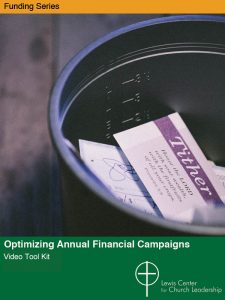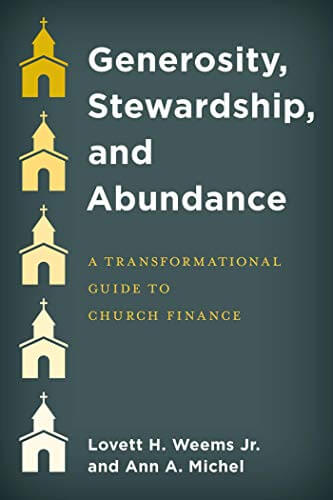Could your church benefit from a more systematic and effective approach to your annual stewardship drive? Ann A. Michel from the Lewis Center staff lays out ten steps that can help your church do a better job of connecting with givers and inspiring generosity.
A commitment campaign or stewardship drive is an annual ritual in many congregations. This exercise is more than a way to generate revenue. A well-executed campaign can be a time for spiritual reflection, mission education, teaching the theology of stewardship, and fostering a sense of shared purpose. These ten steps can help your church conduct a thorough and effective stewardship drive.
1. Build a team.
The most effective commitment campaigns are led by a broad-based team of lay leaders. The pastor’s involvement and support are very critical. But a team approach builds investment in the process and creates a sense of ownership in the outcome. A broadly representative team creates natural connections with people of different ages and different areas of ministry. Who might be part of such a team? You may be lucky enough to have members with experience raising funds for other organizations. But at the end of the day, your most effective stewardship leaders will be those people who are deeply in love with the Lord and with your church. (See “Building Your Stewardship Team,” Leading Ideas, Aug. 9, 2022).
2. Select a fresh theme and approach.
Start with a theme that will catch people’s attention, capture the ethos of your church, and tie together preaching, teaching, and testimony. If your congregation has conducted a fall commitment campaign in the same way for as long as anyone can remember, trying something different will generally yield positive results. For example, if you do a letter writing campaign one year, you might consider a campaign built around house parties the next year. If you need ideas, there are many good, published resources available with everything necessary to implement campaigns built around different themes and modalities. (See “5 Questions for Discerning Your Annual Giving Theme,” Leading Ideas, August 17, 2016).
3. Emphasize the mission not the budget.
In many churches the pledge appeal is closely tied to the annual budget. A line-item budget is often attached to the appeal letter. But trying to meet a line-item budget isn’t a very effective way to motivate people to give. People don’t give to support budgets or balance sheets. They give to support people and programs. So, build your message around mission, vision, and purpose. (See “Changing the Tone of Conversations about Money and Church,” Leading Ideas, Sept. 1, 2020).
4. Tailor your approach to different types of givers.
Many churches have a one-size-fits-all approach to their annual stewardship appeal. Everyone receives the same “Dear Friend” letter. While this approach is simple and easy to execute, it ignores the reality that every church has people at various points in their journey of generosity. Approaching them all with the same appeal just doesn’t make sense from a spiritual or a developmental perspective. It is more effective to tailor different messages to different categories of givers—your most generous givers, good givers with room to grow, those who contribute but do not pledge, those who do not regularly contribute, and new members, for example. Yes, this means that someone needs to be paying attention to who’s who, where they are spiritually, and what they give. But the need to communicate with people about their giving in meaningful and appropriate ways is one of the best arguments in favor of allowing responsible people proper access to giving records. (See “Crafting Better Commitment Campaign Messages,” Leading Ideas, Aug. 19, 2015).
5. Get personal.
Why do people give money to support churches and other causes? The number one reason is because they were asked. People are more likely to give based on their relationship with the person asking than on the merits of the cause. There’s nothing better in any kind of fundraising than a personal invitation, so strive to communicate in the most personal way possible. A personalized letter is better than a form letter. A hand-written note better than a letter. A phone call is better than a note. A one-on-one visit is best of all, which is why visitation is a key element in building campaigns or major fund drives. (See “People Give to People,” Leading Ideas, October 31, 2018).
6. Don’t overlook electronic givers.
Many church members these days consider their recurring electronic gift to be their pledge and they may not see the need to return a pledge card. Identify those who give in this manner. Thank them for their faithful and consistent support, and invite them to consider increasing their gift each year in conjunction with your annual appeal. (See “Now Is the Time to Ask Contributors to Set up Recurring Online Gifts,” Leading Ideas, April 22, 2020).
7. Communicate. Communicate. Communicate.
A commitment campaign is essentially a communication exercise. You’ll want to develop a comprehensive communication strategy that takes advantage of all available means of communication. Consider what printed materials you need—perhaps a brochure, special stationery, or thank you cards in addition to your pledge card. How might you use email, social media, and online giving or pledging? A brief video or slide show is an effective way to illustrate your mission and remind people of all that goes on at your church. And don’t forget the church newsletter, the pastor’s weekly email, the website, visual displays, and banners. (See “The Power of Stories”, Leading Ideas, June 14, 2016).
8. Follow up.
No matter how inspiring and thorough your plan, some sizable percent of your congregation isn’t going to respond to the initial pledge appeal. To finish strong, you need a strategy to bring into the fold those who require a bit more encouragement. Decide in advance how you will reach out to late responders through notes, phone calls, or follow-up visits. But even if you need to contact people repeatedly, avoid shaming or treating them like deadbeats. (See “Planning for a Strong Finish to Your Stewardship Campaign,” Leading Ideas, Aug. 1, 2018).
9. Say Thank You.
Congregations that want to inspire giving thank their givers. And one important juncture for saying thank you is when donors make their pledges. It’s easy to overlook this critical step unless you have a plan in place at the start of your campaign. (See “Developing a Thank You System for Your Church,” Leading Ideas, Nov. 20, 2013).
10. Give it time.
These steps require planning and coordination. Start early and plan ahead. Construct a realistic timeline for your campaign that allows enough time on the front end for planning and preparation and enough on the back end for follow-up and acknowledgements. A good timeline will keep your work on track and help connect campaign activities with the liturgical calendar, preaching topics, and other major church activities.
 Related Resources
Related Resources
- Optimizing Annual Financial Campaigns, a video tool kit from the Lewis Center
- Generosity, Stewardship, and Abundance: A Transformational Guide to Church Finances by Lovett H. Weems Jr. and Ann A. Michel (Rowman and Littlefield, 2021.)
- 50 Ways to Improve Your Annual Stewardship Campaign, a free resource from the Lewis Center







